Throw pillows are such an easy way to refresh your space without spending a fortune. They bring in color, texture, and a bit of personality—suddenly your basic sofa turns into a real focal point. Over the years, I’ve noticed that picking the right pillow combination can totally change the vibe of a room.
Remember to repin your favorite images!
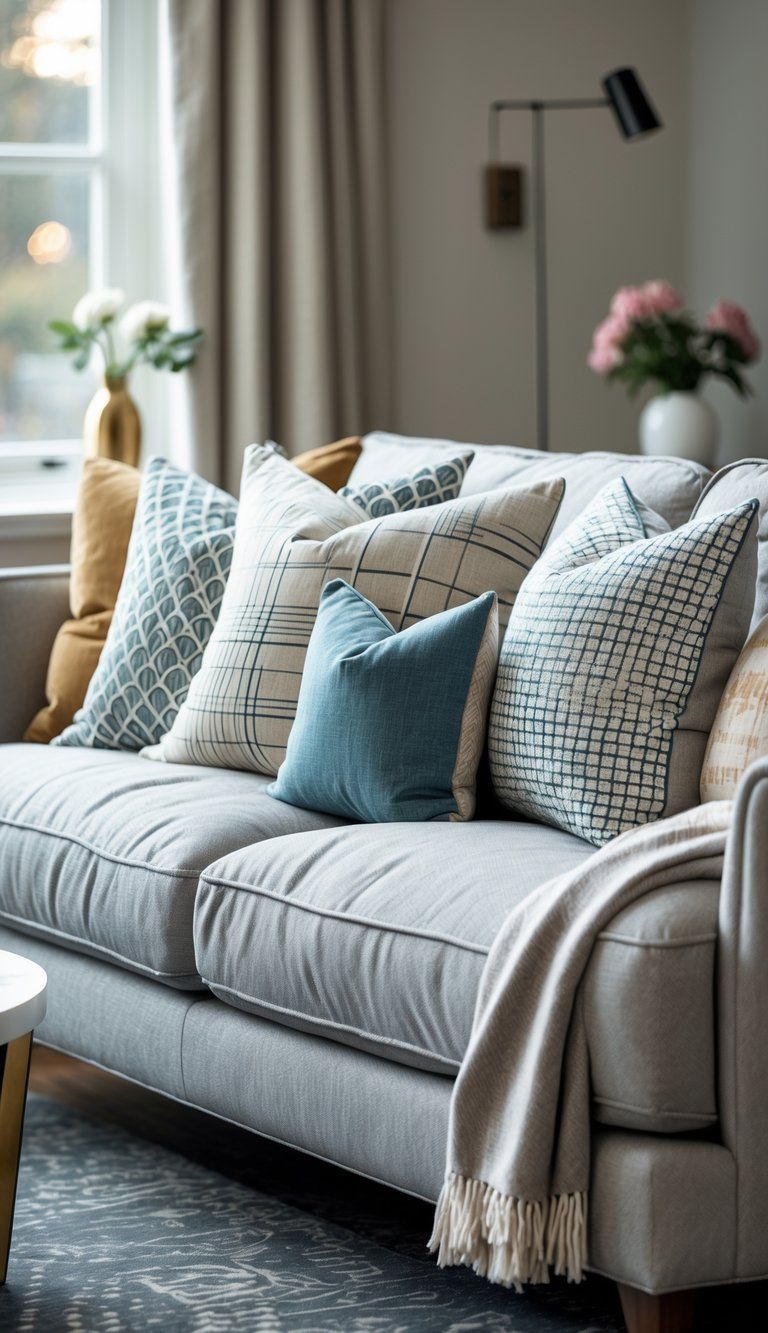
If you want a perfect throw pillow mix, just follow a simple formula: combine patterns, textures, and sizes, but keep your colors cohesive. This approach fits just about any style—modern, boho, coastal, you name it. You really don’t have to splurge; stylish options exist at every price.
Think about using three different pillow sizes for some visual interest. Standard squares come in 16 to 24 inches, but don’t forget lumbar pillows or bolsters to shake things up. The best combos usually include both solids and patterns, and at least one textured pillow for depth.
Understanding Pillow Combinations
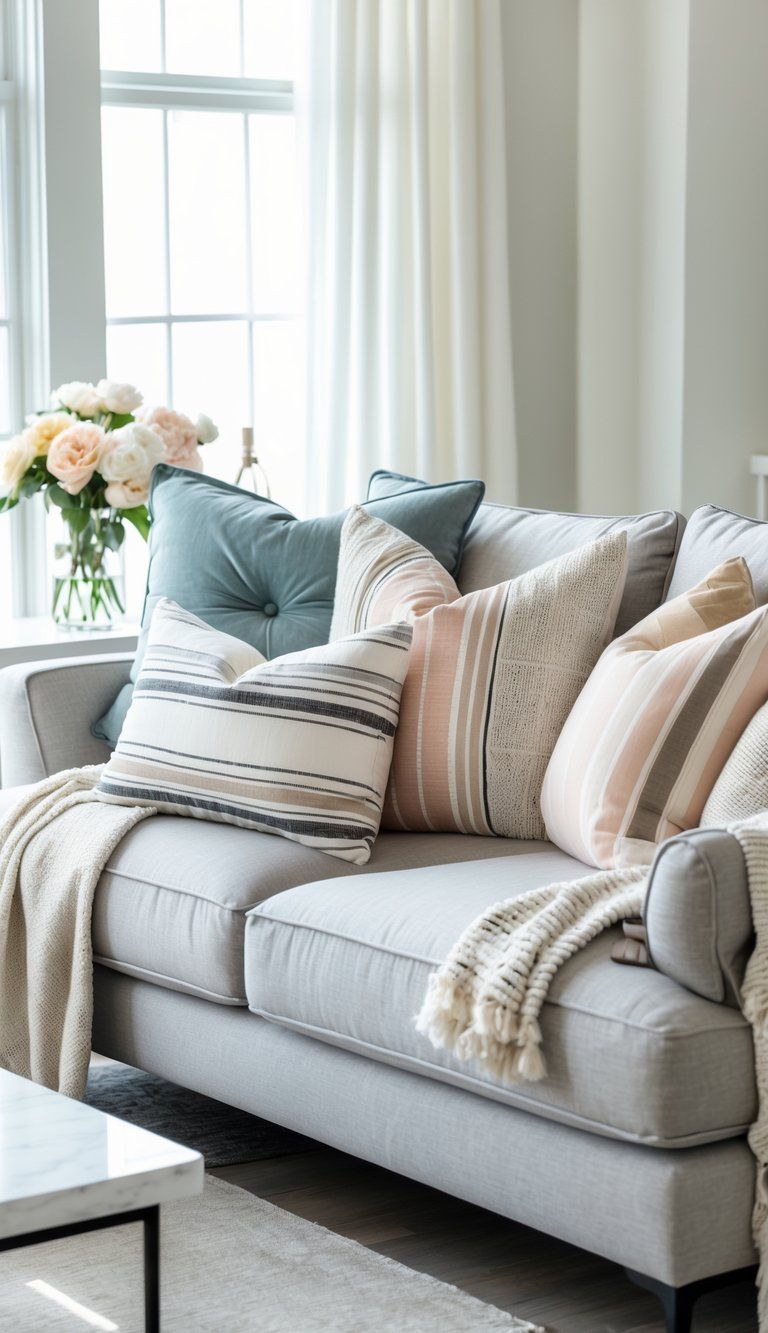
Creating a great throw pillow arrangement is part art, part science. When you get it right, pillow combinations can totally transform a room.
What Makes a Perfect Pillow Combination
A perfect pillow combo balances color, pattern, texture, and size. Start by picking a color scheme that works with what you already have. Two or three complementary colors usually feel just right.
For patterns, try the rule of three:
- One large-scale pattern (think bold florals or big geometrics)
- One medium-scale pattern (like stripes or smaller shapes)
- One small-scale pattern or a textured solid
Texture brings in dimension and makes things interesting. Mix up smooth fabrics like cotton or silk with rougher ones—linen, velvet, or knits. That way, your arrangement looks layered and thoughtful instead of flat.
Variety in size matters too. Put bigger pillows (22-24 inches) at the back, medium ones (20 inches) in the middle, and smaller lumbars or 16-18 inch squares up front.
Key Principles of Layering Pillows
Layering gives your pillows that designer look. Start with the largest pillows at the back corners of your sofa or bed. They set the foundation.
When you layer, keep a few things in mind:
- Odd numbers usually look best—groups of 3 or 5 feel more natural
- Mix up the shapes—try squares with rectangular lumbar or even round pillows
- Balance things out, but skip perfect symmetry—a little variation keeps it interesting
Three to five pillows work well on most sofas. On beds, try 2-3 pillows per side plus a center accent. Don’t crowd the furniture—you still need space to sit or stretch out.
The Interior Designer’s Approach
Interior designers treat pillow combinations like mini design projects. They often start with a “hero” pillow—one standout piece that sets the tone for the rest.
Designers think about:
- The room’s purpose—formal rooms might get structured arrangements, while casual spaces can be more relaxed
- Seasonality—swapping covers for the season keeps things fresh
- Budget—splurge on good inserts, then switch out covers for variety
A lot of designers use the 60-30-10 rule: 60% dominant color, 30% secondary, 10% accent. It’s a simple way to keep things cohesive but not boring.
Honestly, sometimes it’s fun to break the “rules.” Your pillows should show off your style and make you happy.
Choosing the Right Pillows
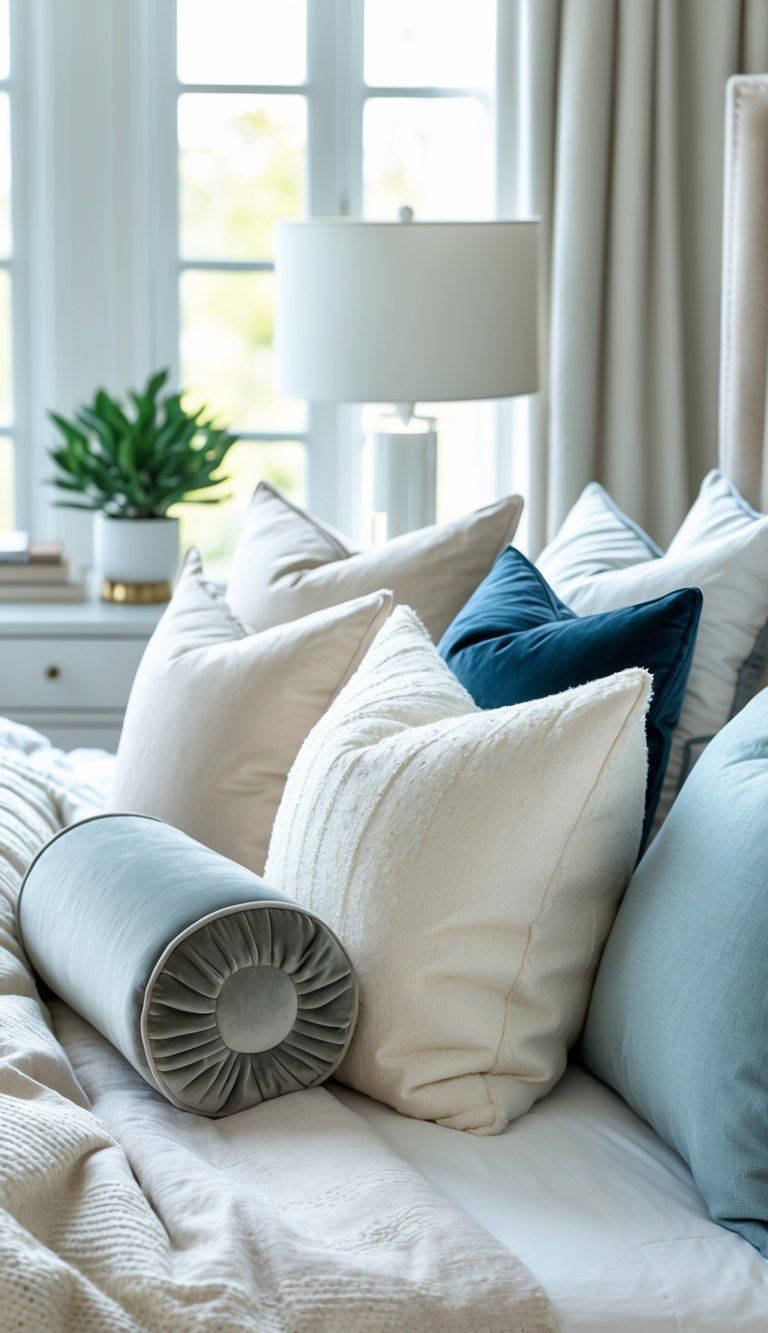
Picking out throw pillows is a little like putting together an outfit. When you balance size, shape, texture, and the unique needs of each room, you can take a space from basic to something special.
Selecting Throw Pillows for Each Room
In the living room, go for pillows that are both sturdy and comfy—they’ll get the most use. Medium to large sizes (18-22 inches) with stain-resistant fabrics work well.
Bedrooms call for softer, cozier pillows. Smaller decorative pillows (16-18 inches) fit nicely, and at least one lumbar pillow adds back support.
Dining areas do best with smaller, firmer pillows (14-16 inches) so they don’t get in the way.
For outdoors, pick weather-resistant materials like Sunbrella. Quick-drying fills and fade-resistant colors help them last.
Each room needs something a bit different. Silk or velvet might suit a formal living room, but a family room needs covers you can toss in the wash.
Mixing Sizes and Shapes
Try the “rule of three” by mixing up sizes and shapes. On a sofa, you might use:
- 2 large square pillows (22-24 inches) as anchors
- 2 medium squares (18-20 inches) up front
- 1 or 2 accents in lumbar or round shapes
Beds can follow this formula:
| Position | Size & Shape | Quantity |
|---|---|---|
| Back | Euro pillows (26″) | 2-3 |
| Middle | Standard/king pillows | 2 |
| Front | Small squares (16-18″) | 2-4 |
| Center | Lumbar (12″×20″) | 1 |
Mix up the heights for depth. Place the largest pillows in the back corners and work your way down in size.
Incorporating Texture for Visual Interest
Texture is what makes pillow combos feel intentional. Combine smooth fabrics with chunkier ones for contrast.
Try pairing:
- Smooth: velvet, silk, linen
- Textured: bouclé, chunky knit, macramé
- Dimensional: tufted, embroidered, fringe
Don’t use all the same texture—it’ll look flat. Aim for at least three different textures in your mix.
Change up textures with the seasons. Wool and velvet are great for winter, while cotton and linen feel light for summer.
Think about how the fabric feels, especially in spots where comfort matters. Scratchy pillows might look cool but aren’t great for lounging.
Color Palette Strategies for Pillow Styling
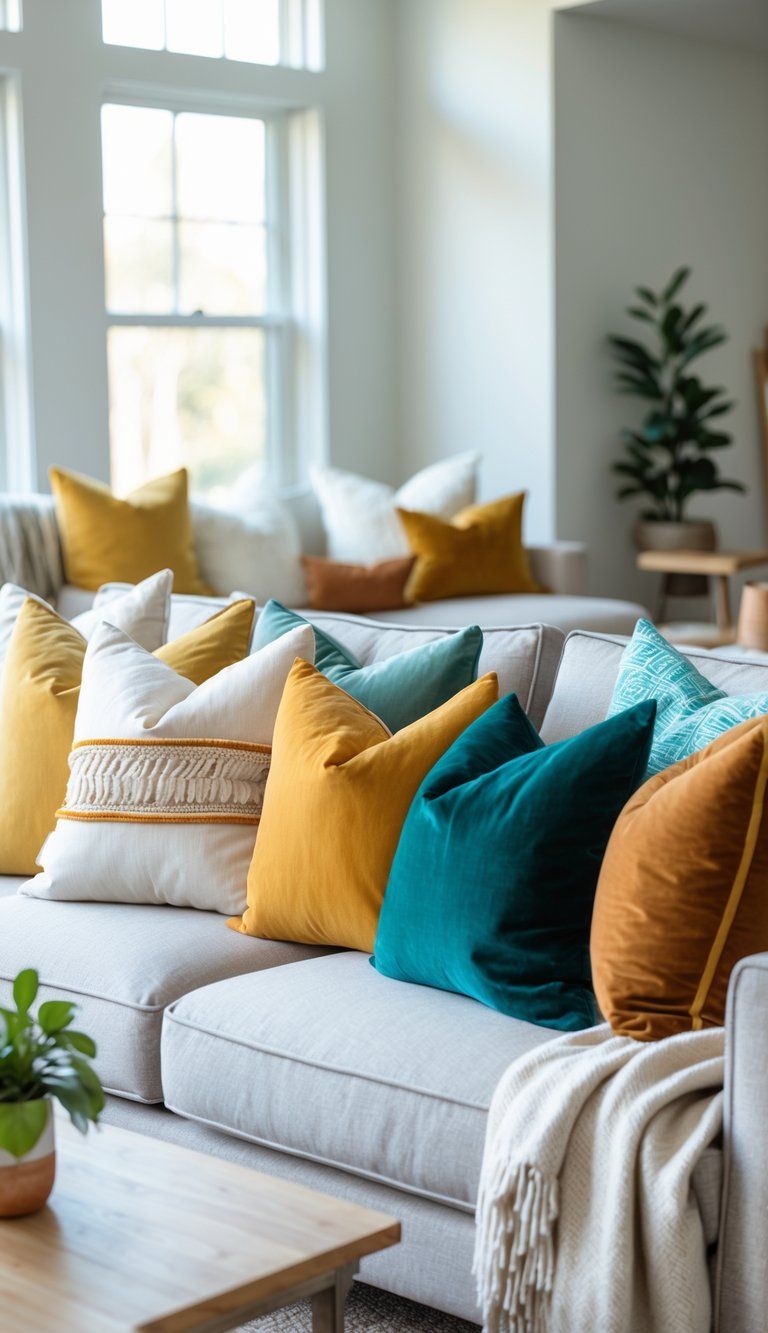
Choosing your color palette is the first step to styling pillows that look intentional. A good palette ties everything together and shows off your personality.
Creating Cohesion with a Color Palette
Check out the colors already in your room—walls, furniture, rugs, artwork. These set your base palette and help you pick pillows that fit in instead of fighting the space.
The 60-30-10 rule works well: 60% dominant color, 30% secondary, 10% accent. If your room’s mostly gray (60%), add navy pillows (30%) and a pop of mustard yellow (10%).
Pull colors from your art or rugs for an easy way to create cohesion. If that painting you love has teal and coral, bring those into your pillow mix.
Pro tip: A color wheel can help. Complementary colors (opposites) or analogous colors (neighbors) usually play well together.
Accent vs. Neutral Tones
Neutral pillows—beige, gray, white, cream—give you a flexible base. They’re perfect if you like to switch things up with the seasons or if your furniture already stands out.
Layer different textures within your neutral palette. A cream linen pillow next to a chunky knit and a subtle pattern adds depth without needing more color.
When you want to use accent colors, keep these ideas in mind:
- Bold accents look best on neutral furniture
- Limit bright colors to one or two so things don’t get too busy
- Use different shades of the same color for a more sophisticated feel
- Balance bold pillows with neutrals for a polished look
Even neutral pillows can make a statement if you play with texture and pattern. Bold colors bring energy and create a focal point.
Incorporating Textures and Fabrics
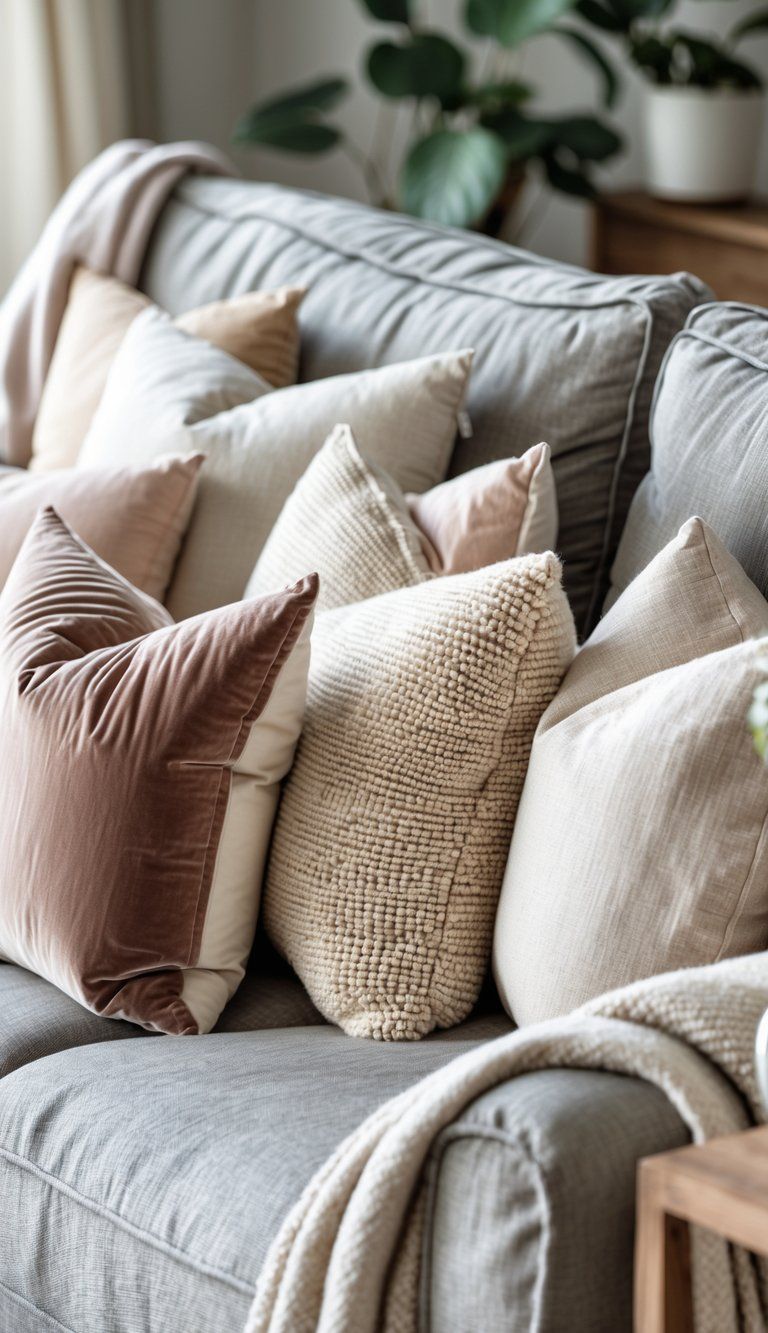
Texture gives pillow combinations life. Mixing different fabrics adds interest and makes a space feel finished, even if you stick to similar colors.
Using Velvet and Other Luxurious Materials
Velvet instantly makes a room feel more luxe. Its plush texture reflects light and adds a rich vibe. When you choose velvet pillows, jewel tones like emerald or sapphire really stand out.
Other luxe fabrics to try:
- Silk for a touch of sheen and elegance
- Linen for laid-back, textured style
- Faux fur for cozy winter vibes
Mixing price points is totally fine. One nice velvet pillow can elevate a few budget-friendly textured ones.
Blending Textures for Depth
Mixing textures is the secret to pro-level pillow combos. Pair a smooth pillow like velvet with something nubby or embroidered.
Try this simple formula:
- One smooth, solid pillow (velvet is always good)
- One textured neutral (maybe woven or nubby)
- One patterned pillow that ties in the colors
Texture variety lets you use a tight color palette without things getting boring. This is especially handy if you like neutrals but want your space to feel layered.
Switch up textures with the seasons. Chunky knits feel right in winter, while linen and cotton keep things light for summer.
Layering Techniques for Visual Impact
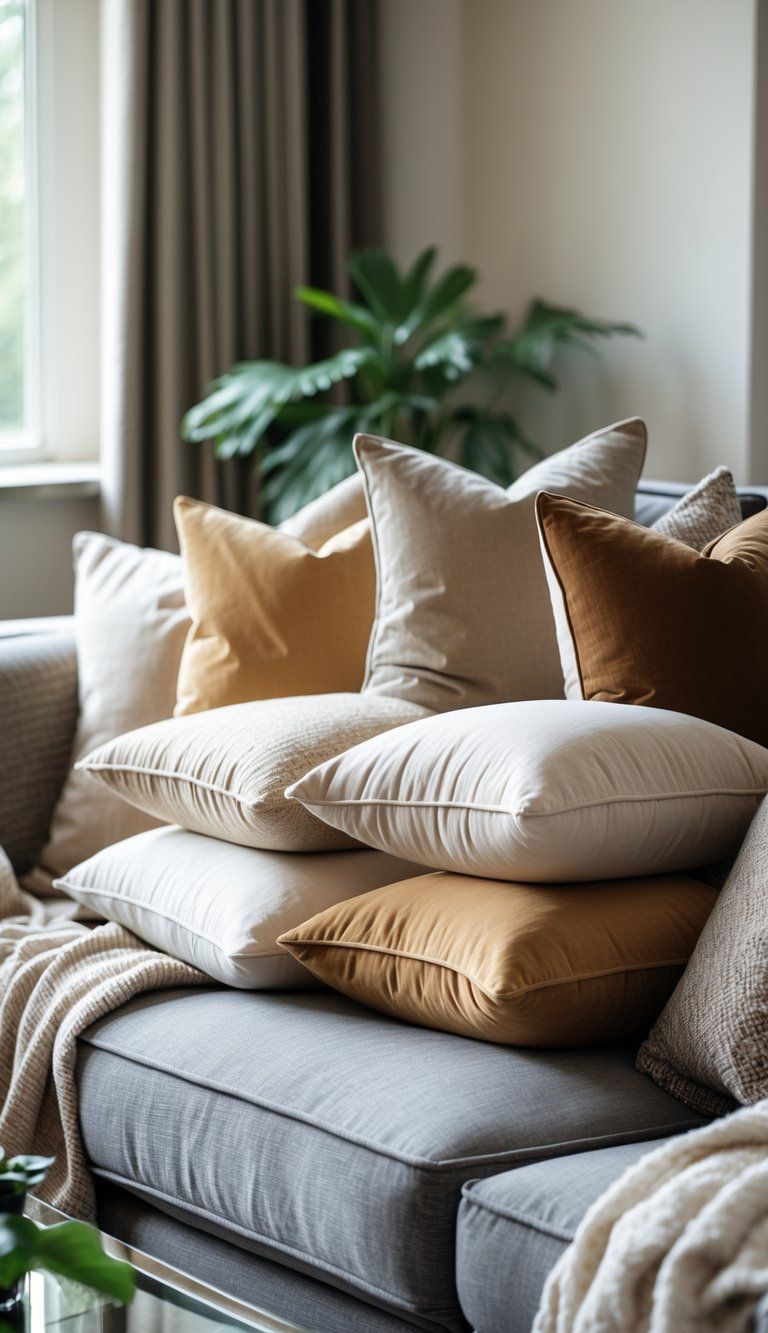
Making an impact with pillows isn’t just about picking pretty colors. It’s about how you arrange and layer them to create depth and a sense of style.
Building Layers with Pattern and Solid Pillows
Start with a solid base. Pick two or three big pillows in solid colors that match your room. These anchor your arrangement.
Add medium-sized pillows with simple patterns—stripes or geometrics work well. They add interest but don’t take over.
Finish with one or two smaller accent pillows in bold patterns or fun textures. These are your “wow” pieces.
Mix up those textures:
- Velvet for richness
- Linen for a casual feel
- Knits for coziness
- Faux fur for a bit of drama
Don’t hesitate to put different materials together. A velvet pillow next to linen just feels right.
Arranging Pillows Like a Professional
How you place your pillows matters. Interior designers usually go from largest in the back to smallest in the front.
Try the “karate chop” trick—give each pillow a gentle chop at the top center. It creates a relaxed, lived-in look.
On sofas, odd numbers (3 or 5) feel more natural. On beds, even numbers give a sense of balance.
A few arranging tips:
- Group similar colors together
- Put contrasting patterns side by side
- Mix up heights and sizes for dimension
- Leave a little space between pillows
Step back now and then to see how everything looks from across the room. Good layering adds depth without making things feel crowded.
Adapting Pillow Combinations for Different Styles
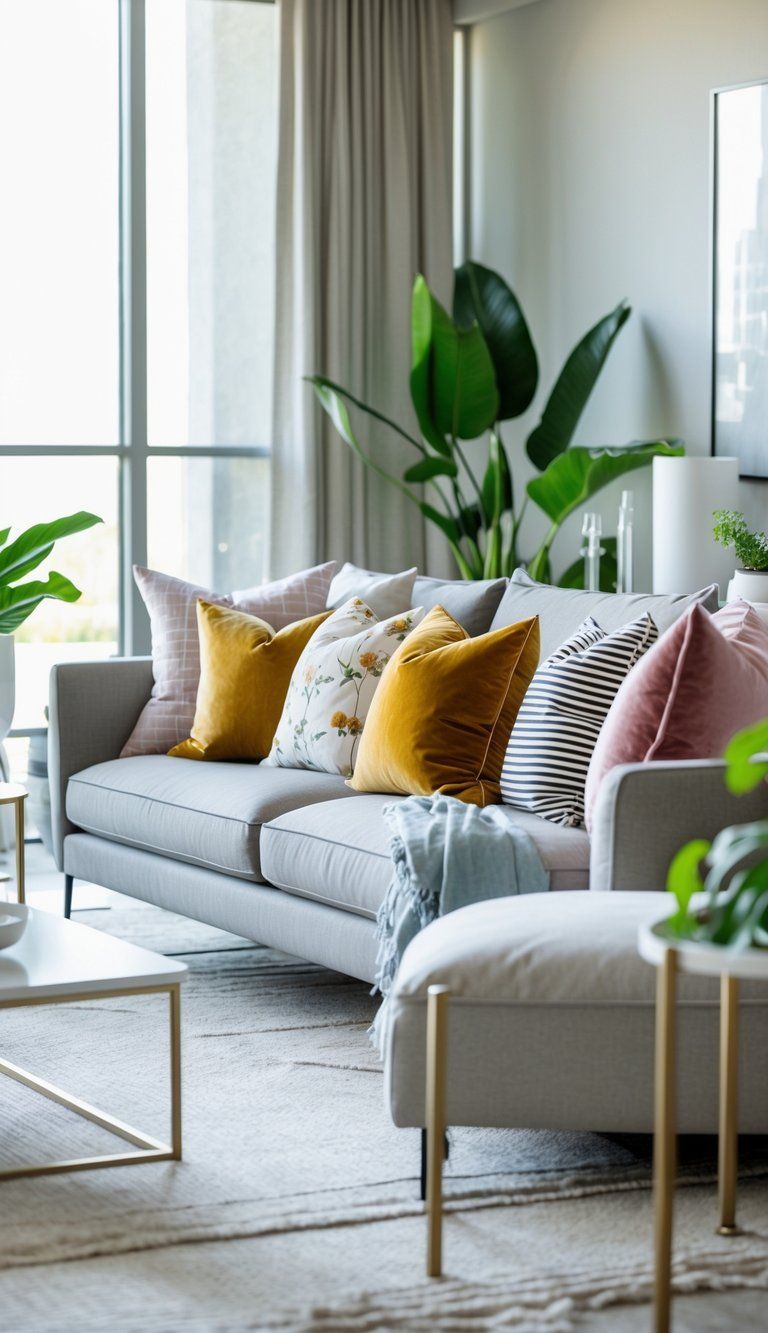
Your home’s style pretty much decides which pillow combos will actually work. Each décor style calls for its own approach to color, texture, and arrangement—otherwise, things can get a bit chaotic.
Modern and Minimalist Spaces
In modern spaces, less really is more. Pick pillows with simple patterns and clean lines that match your color palette.
Stick with two or three neutral shades—gray, white, black. Toss in one accent color with a single pillow if you want a little pop, but don’t go overboard.
Texture makes a difference, even in minimalist rooms. Try these:
- Smooth linen or cotton in solid colors
- Subtle geometric patterns
- Thin stripes or small-scale texture
- One pillow with a bold, simple design
Don’t line up pillows in perfect symmetry—go for an asymmetrical grouping instead. That keeps things interesting without losing the clean vibe.
On big sofas, three to five pillows is usually enough. Small sofas? Even fewer.
Traditional and Classic Rooms
Traditional rooms welcome richer textures and classic patterns. You want your pillows to feel coordinated and elegant, but not like you bought a matching set.
Pull your color palette from what’s already in the room—maybe the rug or a favorite piece of art. Traditional spaces often use:
- Deep jewel tones like burgundy, navy, or emerald
- Warm neutrals (think cream or taupe)
- Patterns like damask, paisley, or florals
Mix up your patterns. Combine a big floral with a small stripe or geometric. Always add at least one solid pillow so your eyes can rest somewhere.
Try this arrangement:
- Place bigger pillows (22″ or 24″) at the corners.
- Add medium-sized ones (20″) next.
- Finish with a special accent pillow in the center.
Eclectic and Bohemian Designs
Bohemian spaces love bold colors and a mix of textures. Here, your pillow choices can get playful and a bit wild.
Mix and match with confidence! Think about:
- Global-inspired patterns (ikat, batik, kilim)
- Textures like tassels, embroidery, or macramé
- Lots of colors, but keep the intensity similar
- Unexpected shapes—round, bolster, whatever catches your eye
Don’t stress about perfect coordination. Aim for a collected, well-traveled look instead. If you want some cohesion, pull one or two colors through a few pillows.
Use different sizes, too. Mix standard squares with oversized floor pillows and small accent cushions.
Natural materials—linen, cotton, wool—fit right in. Handcrafted details tell a story and make the space feel personal.
Seasonal Pillow Arrangements
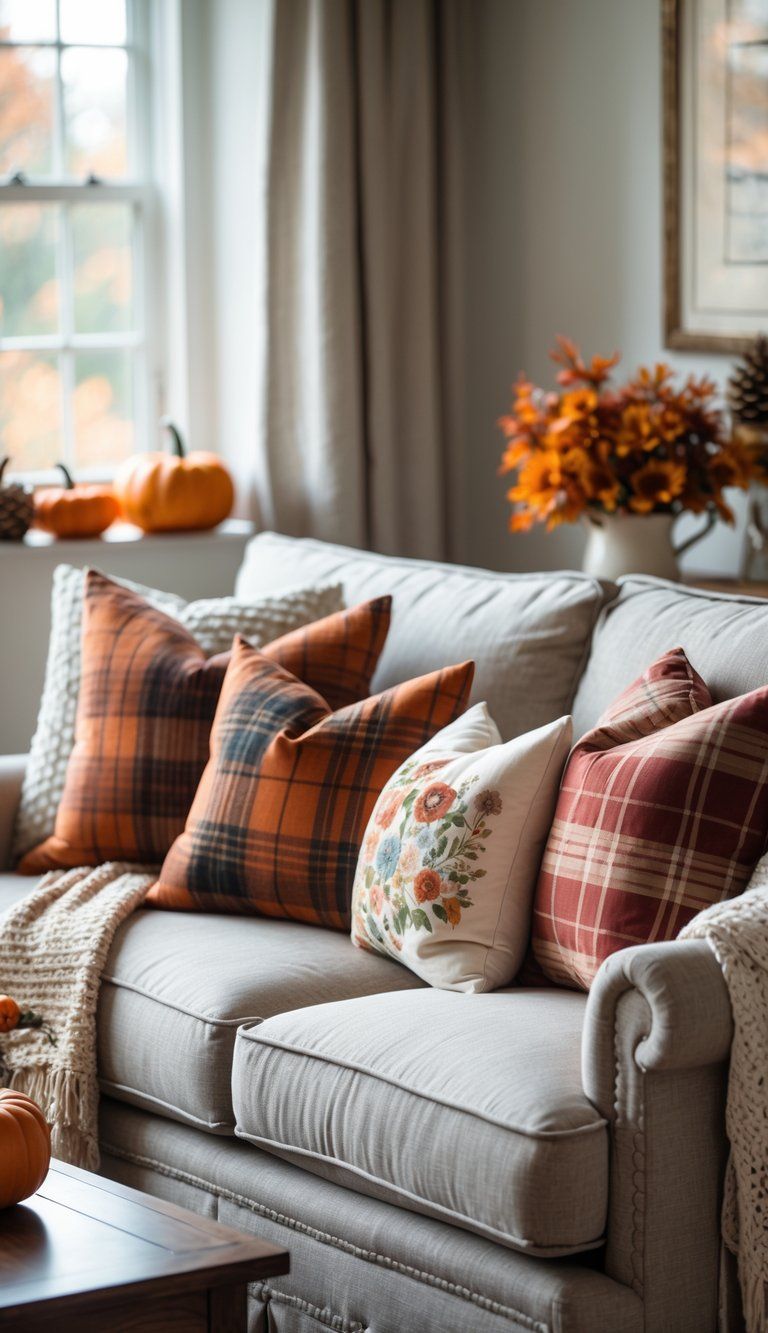
Switching out your throw pillows with the seasons keeps your space feeling fresh. It’s a simple way to change things up without spending a fortune or starting a renovation project.
Refreshing Combinations for Spring and Summer
Spring and summer call for breezy, light pillow arrangements. Go for crisp whites, soft blues, and gentle greens—basically, whatever reminds you of the outdoors.
Color Palette Ideas:
- Seafoam green with white and coral
- Lemon yellow with sky blue
- Lavender paired with white and silver
Pick lightweight fabrics like linen and cotton. They feel cool and keep things relaxed. Botanical and floral prints look great in warmer months.
Try mixing a couple of solid colors with one bold pattern. For example, two aqua pillows plus a tropical print creates balance without overdoing it.
Remember your outdoor spaces, too. Weather-resistant pillows in bright shades can totally transform a patio or deck.
Cozy Pillows for Fall and Winter
When it gets chilly, your pillow setup should feel warm and inviting. Fall and winter need deeper colors and richer textures.
Best Fall/Winter Textures:
- Chunky knits
- Velvet
- Faux fur
- Wool blends
Layer a few textures for both comfort and visual interest. Pair a velvet pillow with a cable knit for instant coziness.
Color-wise, try jewel tones—emerald, burgundy, navy. Earthy neutrals like camel, rust, or forest green work well too.
Add some metallic touches with pillows that have gold or copper threads. They’ll catch candlelight or firelight and add a festive vibe.
For a quick update, keep your big pillows neutral and just swap out the smaller ones as the seasons change.
Practical Tips for Long-Lasting Pillow Displays
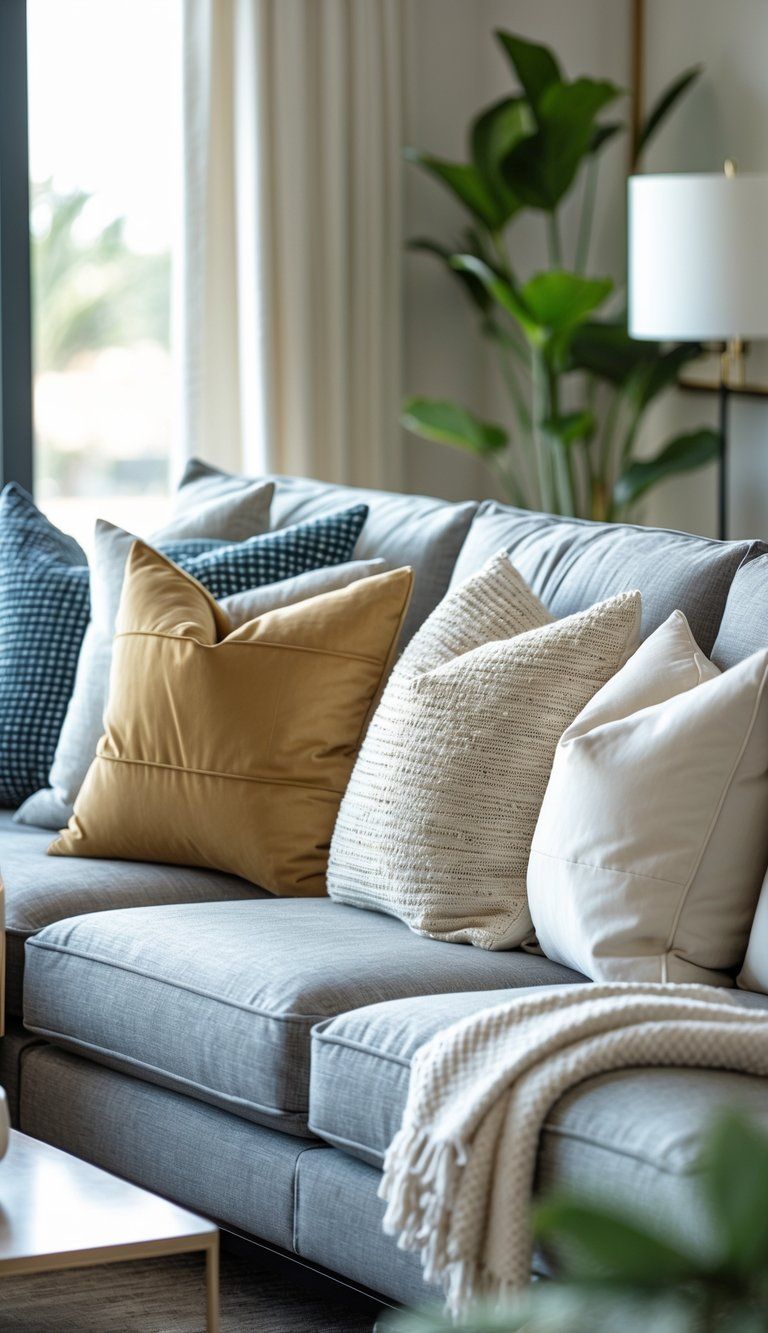
Making beautiful pillow combos is just the start. If you want them to last, you’ll need to put in a bit of care and thought.
Caring for Pillows and Covers
Rotate your throw pillows every few weeks. This helps prevent uneven wear and keeps the colors from fading in spots that get more sunlight.
Always check the cleaning instructions on the tags. Most covers can go in the wash on cold, but inserts usually need spot cleaning or professional help.
Store off-season pillows in breathable containers. Drop in a cedar block to keep moths away. Vacuum-sealed bags can save space, but they’ll flatten your pillows—so fluff them up before using again.
Invest in good inserts if you can. Down and feather last longer than polyester, though they need more care. Memory foam offers durability, but swap it out if it starts to lose its shape.
Quick Cleaning Tip: Keep a lint roller handy for fast touch-ups between deeper cleans.
Balancing Comfort and Style
Pick pillows that look good but also feel great. After all, nobody wants a gorgeous pillow that’s too stiff to actually use.
Try out your pillow setup by sitting down and seeing how it feels. You want your display to make the seat comfier, not turn it into an awkward perch.
On beds and sofas, put firmer pillows in the back and toss softer ones in front. That way, you get some nice depth and your back gets the support it needs.
Go for tough fabrics in spots where people sit a lot. Linen and cotton blends hold up well, while silks—honestly—are better left for those fancy rooms nobody really uses.
Designer Trick: Keep a few neutral pillow covers around. Swapping them out for the season feels way easier than replacing your whole pillow collection.

